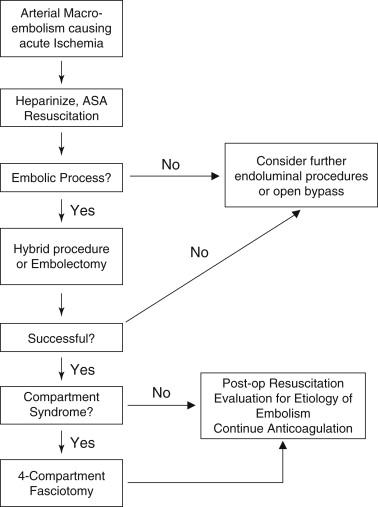Physical Address
304 North Cardinal St.
Dorchester Center, MA 02124
Arterial macroembolism causes significant morbidity and is associated with mortality. In the limb, an arterial macroembolism causes one of the most common vascular emergencies: acute limb ischemia (ALI). Prompt recognition and diagnosis followed by rapid restoration of blood flow to the ischemic extremity decreases limb loss and reperfusion-related local and remote organ injury. This disease most often occurs in aged patients, who often have significant comorbidities that can lead to their death even after successful revascularization of a limb.
A standard system for categorizing limb ischemia is the Society for Vascular Surgery/International Society for Cardiovascular Surgery (SVS/ISCVS) joint consensus document. Class I is a viable limb that is not immediately threatened, has no sensory or muscle weakness, and has audible arterial Doppler and venous Doppler signals. Category II is a threatened limb. Category IIA is a limb marginally threatened with minimal to no sensory loss, inaudible arterial Doppler signals, and audible venous Doppler signals. Category IIB is an immediately threatened limb and is associated with sensory loss and associated mild muscle weakness with inaudible arterial and venous signals. Category III is irreversible limb ischemia, with major tissue loss or permanent nerve damage, a profoundly anesthetic and paralyzed limb, and inaudible signals.
The pathophysiology of arterial macroembolism is caused by an abrupt and complete blockage of the main arterial supply to an extremity or end organ. Unlike in chronic critical limb ischemia, sufficient collaterals are not well developed. Patients often note the exact time the event occurs. The distal tissue bed becomes ischemic, with energy metabolism shifting from an aerobic to an anaerobic process. Progressive ischemia leads to cell dysfunction and death. Upon reperfusion, release of cellular injury products can cause systemic organ injury such as renal and pulmonary failure. Nerve tissues, followed by muscle cells, are most susceptible and account for the pain followed by the neurologic symptoms. A patient without underlying vascular disease and an acute arterial blockage has approximately 6 hours to undergo revascularization before irreversible functional tissue damage occurs. This is particularly true in young patients.
Arterial macroembolism is most commonly from a cardiac source. This is typically observed in a patient who has atrial fibrillation with left atrial thrombus or after a myocardial infarction with left ventricular thrombus. Common locations of embolic lodgment are at arterial bifurcations where the artery caliber changes, such as the aortic bifurcation (∼35%), femoral bifurcation (∼50%), or popliteal artery (∼12%).
The diagnosis is made with combination of history and physical examination findings. The classic findings are the six P s: pain, pulselessness, poikliothermia, pallor, paresthesias, and paralysis. Often, the location of the embolism can be determined by physical examination. For example, a new-onset atrial fibrillation, right-leg ALI, nonpalpable right femoral pulse, and normal left lower extremity pulse suggests thromboembolism in the iliac artery. Conversely, an aged patient who has long-standing arterial atherosclerotic disease and claudication and who presents with a cool right leg, a weakly palpable femoral pulse, and only Doppler signals in the contralateral nonaffected side probably does not have an embolic etiology causing the limb ischemia. Other nonembolic etiologies of ALI include in-situ arterial thrombosis, peripheral bypass thrombosis, peripheral arterial aneurysms, trauma (popliteal artery disruption or penetrating injury), or acute aortic dissection with occlusion of the aorta or iliac arteries.
Men and women are equally affected by ALI. Modern series amputation rates are 13%, mortality is approximately 10%, and the average hospital length of stay is approximately 10 days. Generally, ALI does not occur in young people outside of trauma. In young patients it may be a result of unusual circumstances such as paradoxical emboli or hypercoagulable disorders, or it occurs in those with severe early-onset cardiac disease.
Excellent judgment is needed in the assessment of late grade 3 limb ischemia. It is important not to attempt limb salvage in those with nonrecoverable ischemia, because the tissue is not viable. If an examination suggests marginal viability, revascularization with reassessment of tissue viability is reasonable, with close observation and a low threshold to amputate if dictated by clinical status. A discussion with the patient and the patient’s family is important, given the high potential for limb loss.
Two primary factors underlie the morbidity and mortality that results from ALI, namely, the patient’s underlying comorbid illness and a delay in recognition and revascularization. Not surprisingly, skin mottling and rest pain are associated with increased risk of amputation. Another study suggested that ALI-related mortality was increased with delay in treatment of ischemia, significant underlying atherosclerosis, and poor arterial backbleeding at operation. Other factors associated with decreased amputation-free survival include ethnicity other than European, older age, a history of neurologic disease, malignancy, congestive heart failure, and low body weight.
Choosing the appropriate therapy is also an important factor to decrease amputation occurrence and mortality ( Figure 1 ). Although strong evidence suggests equivalence of endovascular or open surgical therapies, in terms of mortality and amputation, the etiology of the ALI needs to be factored into this equation.

Two articles published in the 1990s suggested that thrombolytic therapy had equivalent outcomes for surgical therapy in patients with ALI. These were the Surgery or Thrombolysis in Lower Extremity Ischemia (STILE) and Thrombolysis or Peripheral Artery Surgery (TOPAS) trials, which randomized patients to arteriography and thrombolytic therapy with urokinase, versus arteriography and embolectomy or urgent bypass. Although these data are robust, a majority of patients in both of these trials had Class I and IIA ischemia, and less than 25% had class IIB or III limb ischemia caused by arterial macroembolism.
A large national database study of patients with an embolic etiology (generally stage IIb ischemia) suggested that amputation was significantly less likely with embolectomy compared to thrombolytic therapy. Patients who failed thrombolytic therapy had a much greater risk of amputation and death than those primarily treated with embolectomy.
Become a Clinical Tree membership for Full access and enjoy Unlimited articles
If you are a member. Log in here